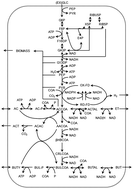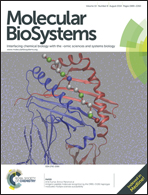Elementary mode analysis reveals that Clostridium acetobutylicum modulates its metabolic strategy under external stress†
Abstract
Clostridium acetobutylicum is a strict anaerobe which exhibits two distinct steps in its metabolic network. In the first step, sugars are oxidized to organic acids (acetic and butyric). This is accompanied with growth. The acids produced in the first phase are re-assimilated into solvents (acetone, butanol, and ethanol) in the second phase of metabolism. The two phases are hence called acidogenesis and solventogenesis, respectively. In this work, using Elementary Mode Analysis (EMA), we quantify fluxes through Elementary Modes under different physical and chemical conditions. Our analysis reveals that, in response to external stresses, the organism invokes Elementary Modes which couple acidogenesis and solventogenesis. This coupling leads to the organism exhibiting characteristics of both, acidogenesis and solventogenesis at the same time. Significantly, this coupling was not invoked during any “unstressed” conditions tested in this study. Overall, our work highlights the flexibility in Clostridium acetobutylicum to modulate its metabolism to enhance chances of survival under harsh conditions.


 Please wait while we load your content...
Please wait while we load your content...